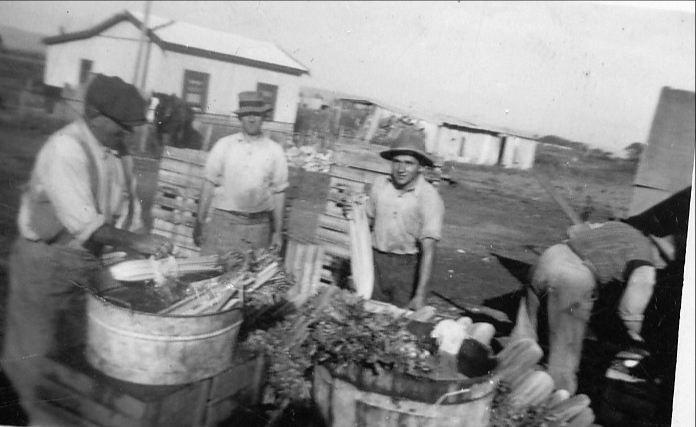Autumn has begun in Adelaide by the calendar. However, with the current heatwave, it feels like the hottest days of summer. The season of autumn was the time of harvesting some crops in market gardens.
In the image above, members of the Santin family and other men wash celery. It was taken in the mid 1940s on Valetta Road. The photo was provided by the family.
Autumn was also time to pick apples, pears and persimmons. The early market gardeners brought customs from the Veneto region and created their own ways of of experiencing autumn. They bought chestnuts and shared the ritual of roasting and eating them. They bought grapes at McLaren Vale or the Barossa Valley each year for making wine. Some picked olives to make olive oil and as the weather cooled found mushrooms in the hills or other rural areas. The families transposed their food and wine traditions and enjoyed the bounty of autumn months in the southern hemisphere.
A delightful sign of autumn is the first flowering of the crocus. Here is a small display in our garden at Flinders Park taken today.

In the oral history interviews, sons and daughters of the first generation of market gardeners spoke about their experience of the Veneto traditions. In this blog, you can read just few of the memories of autumn rituals in families.
Harvesting celery
Louis Ballestrin, OH 872/61
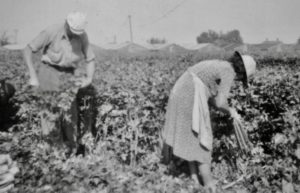
Louis spoke about the celery that his parents and aunt and uncle grew on Hartley Road at Flinders Park:
Celery, it was full on, probably nine, nine months a year by the time you start sowing the seed in January and let the seed grow to six inches tall. And then … you had to pull them all out and then all of them were transplanted … it’s not a very fast-growing vegetable, and by the time they grew up and it was harvested, it took a long time … It started early to late autumn and through to early spring for four or five months. [The celery] was all sent over to Melbourne.
Roasting chestnuts
Lina Rismondo nee Marchioro, OH 872/9
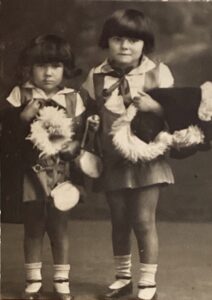
Lina, who was born in 1927, remembered gatherings of the first generation of the market gardeners when most of the men were by themselves in Adelaide either waiting for their wives or children to join them or waiting to find wives. As a small child, Lina remembered the small group roasting chestnuts together and singing – a way of linking back to their families in the Veneto region. In the early 1930s, there were only two women, in the group – Lina’s mother, Margherita Marchioro, and Lina Rossetto nee Bordin who had arrived in 1930. She remembered the men singing songs that they would have heard in their families – “La Montanara” and “Quel Masolin dei Fiori.”
At least twice a week the men would go there of a night time and Mum would be roasting some chestnuts and the men would be singing, and that was lovely. I can still hear them singing … about seven or eight of them, yeah, mostly bachelors, of course. One by one they got their wives from Italy and there was another Mr Atto Rossetto, he used to come from the city to come down and spend the evening with these men, you know, they were all bachelors, and they all knew each other … Oh, the singing was beautiful. I can still hear them singing. I feel as though, you know, I can remember them all standing out with their arms around each other’s shoulders, you know, singing away [laughs].
Sandra Conci nee Santin, OH 872/44
Sandra grew up on Frogmore Road close to her Santin and Tonellato grandparents, uncles, aunts and cousins. Sandra recalled roasting chestnuts as a big family event.
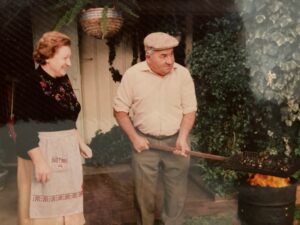
Oh, that was, that was fun, they used to get together for castagna, one time it was at my zia Clara, other times, not many times at zia Anna’s, more so zia Clara’s place and my mother’s place. And they used to come in and bring their bottle of wine, just sit around, talk, laugh, think about the castagna and they used to cook the castagna … Dad used to bring them from the market, when he used to go to the market and so they use to cook them in like a grill. Zio Romildo … was good at making things so he used to do a lot of things and he used to grill them and Mum [also] used to cook them in the oven
The Trevisani nel Mondo hosts castagna events in Adelaide and they are very popular.
Making wine
Making wine was an important autumn activity in many families. It was important for people like Angelo Innocente to make wine every year. Angelo continued this tradition until he was 89 years of age.

Roma Bordignon nee Zampin, OH 872/41
Roma Bordignon nee Zampin remembered the ritual of making the wine in her family. Her father Silvano (known as Gerry) involved his daughters in the process of treading the grapes. This tradition was something that the local policeman appreciated:
We used to get into the big bucket or whatever it was, and we’d go with our feet and we’d dance the Tarantella [laughter] … And [Dad would] say, “Come on girls. Hurry up! We’ve got to make this wine.” So, we’d dance faster.
And the Lockleys policeman at the time, he used to come up to see Gerry, as they called Dad. And he’d say, “How are you going Gerry? Have you made the wine yet?” And he’d say, “Yeah. Would you like a taste?” So, he’d sit down and drink it. He only come up to see him for a drink.

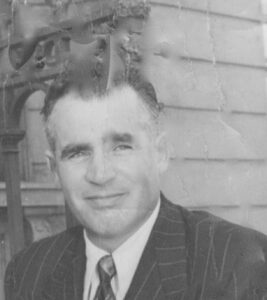
Milva Rebuli nee Zampin, OH 872/36
Milva, Roma’s older sister, spoke about their father storing the wine in a barrel in a cellar at the back of the property their parents leased as market gardens on Henley Beach Road at Lockleys. Milva remembered that her father made a cellar from a dugout that had been made by American soldiers who camped along the southern side of the River Torrens during World War II.
But Dad always made his own wine. We had a cellar down the back because we had the —- American soldiers at the back of our place at that time. They had dugouts and when they left, we had the dugouts, they more or less filled in most of them but they left one, and Dad used to put all of his wine in the cellar out the back.
The fruit of autumn – persimmons
In Italy, persimmon trees provide a wonderful display of dangling orange fruits that hang on branches without leaves in autumn. Sometimes they are visible even as winter sets in. It seems that in some villages every garden has a persimmon tree. Here in Adelaide, they are not as popular but many people of Veneto heritage have a tree – or they know where they can get cachi so they can enjoy them while they are in season. They patiently wait until the fruit gets really soft and ripe before savouring them.
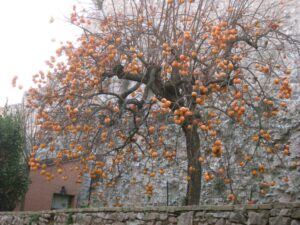
Madeleine Regan
10 March 2024
